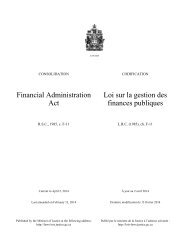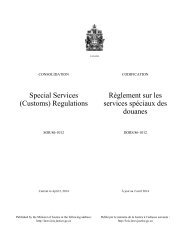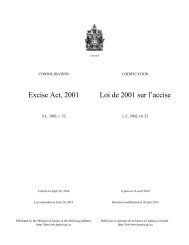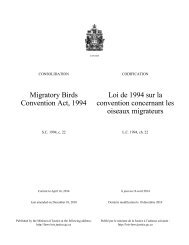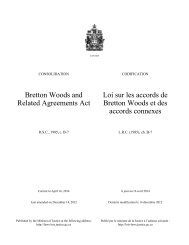Normes sur les ponts-bascules ferroviaires pour pesage en ...
Normes sur les ponts-bascules ferroviaires pour pesage en ...
Normes sur les ponts-bascules ferroviaires pour pesage en ...
Create successful ePaper yourself
Turn your PDF publications into a flip-book with our unique Google optimized e-Paper software.
CANADACONSOLIDATIONCODIFICATIONRailway Track Sca<strong>les</strong> forIn-Motion WeighingSpecifications<strong>Normes</strong> <strong>sur</strong> <strong>les</strong> <strong>ponts</strong>bascu<strong>les</strong><strong>ferroviaires</strong> <strong>pour</strong><strong>pesage</strong> <strong>en</strong> mouvem<strong>en</strong>tSI/91-21TR/91-21Curr<strong>en</strong>t to April 2, 2014 À jour au 2 avril 2014Published by the Minister of Justice at the following address:http://laws-lois.justice.gc.caPublié par le ministre de la Justice à l’adresse suivante :http://lois-laws.justice.gc.ca
OFFICIAL STATUSOF CONSOLIDATIONSCARACTÈRE OFFICIELDES CODIFICATIONSPublishedconsolidation isevid<strong>en</strong>ceSubsections 31(1) and (3) of the LegislationRevision and Consolidation Act, in force onJune 1, 2009, provide as follows:31. (1) Every copy of a consolidated statute orconsolidated regulation published by the Ministerunder this Act in either print or electronic form is evid<strong>en</strong>ceof that statute or regulation and of its cont<strong>en</strong>tsand every copy purporting to be published by theMinister is deemed to be so published, un<strong>les</strong>s thecontrary is shown.... [...]Les paragraphes 31(1) et (3) de la Loi <strong>sur</strong> larévision et la codification des textes législatifs,<strong>en</strong> vigueur le 1 er juin 2009, prévoi<strong>en</strong>t ce quisuit :31. (1) Tout exemplaire d'une loi codifiée ou d'unrèglem<strong>en</strong>t codifié, publié par le ministre <strong>en</strong> vertu dela prés<strong>en</strong>te loi <strong>sur</strong> support papier ou <strong>sur</strong> support électronique,fait foi de cette loi ou de ce règlem<strong>en</strong>t et deson cont<strong>en</strong>u. Tout exemplaire donné comme publiépar le ministre est réputé avoir été ainsi publié, saufpreuve contraire.Codificationscomme élém<strong>en</strong>tde preuveInconsist<strong>en</strong>ciesin regulations(3) In the ev<strong>en</strong>t of an inconsist<strong>en</strong>cy betwe<strong>en</strong> aconsolidated regulation published by the Ministerunder this Act and the original regulation or a subsequ<strong>en</strong>tam<strong>en</strong>dm<strong>en</strong>t as registered by the Clerk of thePrivy Council under the Statutory Instrum<strong>en</strong>ts Act,the original regulation or am<strong>en</strong>dm<strong>en</strong>t prevails to theext<strong>en</strong>t of the inconsist<strong>en</strong>cy.(3) Les dispositions du règlem<strong>en</strong>t d'origine avecses modifications subséqu<strong>en</strong>tes <strong>en</strong>registrées par legreffier du Conseil privé <strong>en</strong> vertu de la Loi <strong>sur</strong> <strong>les</strong>textes réglem<strong>en</strong>taires l'emport<strong>en</strong>t <strong>sur</strong> <strong>les</strong> dispositionsincompatib<strong>les</strong> du règlem<strong>en</strong>t codifié publié par le ministre<strong>en</strong> vertu de la prés<strong>en</strong>te loi.Incompatibilité— règlem<strong>en</strong>tsNOTENOTEThis consolidation is curr<strong>en</strong>t to April 2, 2014. Anyam<strong>en</strong>dm<strong>en</strong>ts that were not in force as of April 2,2014 are set out at the <strong>en</strong>d of this docum<strong>en</strong>t underthe heading “Am<strong>en</strong>dm<strong>en</strong>ts Not in Force”.Cette codification est à jour au 2 avril 2014. Toutesmodifications qui n'étai<strong>en</strong>t pas <strong>en</strong> vigueur au 2 avril2014 sont énoncées à la fin de ce docum<strong>en</strong>t sous letitre « Modifications non <strong>en</strong> vigueur ».
TABLE OF PROVISIONSTABLE ANALYTIQUESection Page Article PageSpecifications Relating to the Design,Composition, Construction andPerformance of Electronic RailwayTrack Sca<strong>les</strong> for In-Motion Weighingand Relating to the Installation andUse Thereof<strong>Normes</strong> de conception, decomposition, de construction et defonctionnem<strong>en</strong>t des <strong>ponts</strong>-bascu<strong>les</strong><strong>ferroviaires</strong> de type électroniquedestinés au <strong>pesage</strong> <strong>en</strong> mouvem<strong>en</strong>t,ainsi que <strong>les</strong> caractéristiques de leurinstallation et utilisation1 SHORT TITLE 1 1 TITRE ABRÉGÉ 12 INTERPRETATION 1 2 DÉFINITIONS 13 APPLICATION 2 3 APPLICATION 24 DESIGN, COMPOSITION ANDCONSTRUCTION 24 CONCEPTION, COMPOSITION ETCONSTRUCTION 24 WHEEL DETECTORS 2 4 DÉTECTEURS DE ROUES 25 OPERATING MODES 2 5 MODES DE FONCTIONNEMENT 211 PRINTER 3 11 IMPRIMANTE 312 TRACK SCALES FOR UNIT TRAINS 4 12 PONTS-BASCULES POUR TRAINS-BLOCS 413 VELOCITY RESTRICTION 4 13 LIMITATION DE VITESSE 415 WEIGHBRIDGES 5 15 TABLIER DE PESAGE 518 WARM-UP DELAY 5 18 INTERDICTION EN RÉCHAUFFEMENT 519 PREVENTION OF REGISTRATION 5 19 ASSERVISSEMENT 520 ROLLBACK 5 20 INVERSION DE MARCHE 521 AUTOMATIC TRACK SCALE 5 21 PONT-BASCULE À FONCTIONNEMENTAUTOMATIQUE 522 INSTALLATION AND USE 6 22 INSTALLATION ETUTILISATION 622 APPROACH AND DEPARTURE RAILS 6 22 RAILS D’APPROCHE ET DE SORTIE 625 TARE 6 25 TARE 629 SAFEGUARDS 7 29 PRÉCAUTIONS 73
RegistrationEnregistrem<strong>en</strong>tSI/91-21 February 27, 1991 TR/91-21 Le 27 février 1991WEIGHTS AND MEASURES ACTRailway Track Sca<strong>les</strong> for In-Motion WeighingSpecificationsLOI SUR LES POIDS ET MESURES<strong>Normes</strong> <strong>sur</strong> <strong>les</strong> <strong>ponts</strong>-bascu<strong>les</strong> <strong>ferroviaires</strong> <strong>pour</strong><strong>pesage</strong> <strong>en</strong> mouvem<strong>en</strong>tThe Minister of Consumer and Corporate Affairs, pursuantto paragraph 10(1)(i) of the Weights and Mea<strong>sur</strong>esAct and sections 13 * and 27 * of the Weights and Mea<strong>sur</strong>esRegulations, C.R.C., c. 1605, hereby establishesthe annexed Specifications relating to the design, composition,construction and performance of electronicrailway track sca<strong>les</strong> for in-motion weighing and relatingto the installation and use thereof.January 28, 1991 Le 28 janvier 1991PIERRE BLAISMinister of Consumer and Corporate AffairsEn vertu de l’alinéa 10(1)i) de la Loi <strong>sur</strong> <strong>les</strong> poids etme<strong>sur</strong>es et des artic<strong>les</strong> 13 * et 27 * du Règlem<strong>en</strong>t <strong>sur</strong> <strong>les</strong>poids et me<strong>sur</strong>es, C.R.C., ch. 1605, le ministre desConsommateurs et des Sociétés établit <strong>les</strong> <strong>Normes</strong> deconception, de composition, de construction et de fonctionnem<strong>en</strong>tdes <strong>ponts</strong>-bascu<strong>les</strong> <strong>ferroviaires</strong> de type électroniquedestinés au <strong>pesage</strong> <strong>en</strong> mouvem<strong>en</strong>t, ainsi que <strong>les</strong>caractéristiques de leur installation et utilisation, ciaprès.Le ministre des Consommateurs et des SociétésPIERRE BLAIS*SOR/78-792, 1978 Canada Gazette Part II, p. 3894*DORS/78-792, Gazette du Canada Partie II, 1978, p. 3894
SPECIFICATIONS RELATING TO THE DESIGN,COMPOSITION, CONSTRUCTION ANDPERFORMANCE OF ELECTRONIC RAILWAYTRACK SCALES FOR IN-MOTION WEIGHINGAND RELATING TO THE INSTALLATIONAND USE THEREOFSHORT TITLE1. These Specifications may be cited as the RailwayTrack Sca<strong>les</strong> for In-Motion Weighing Specifications.INTERPRETATION2. (1) In these Specifications,“Act” means the Weights and Mea<strong>sur</strong>es Act; (Loi)“actual tare” means the actual weight of an empty railwaycar determined by in-motion weighing; (tare réelle)“double weighing” means the weighing of a railway carin two phases on the same track scale the results ofwhich are automatically added together to register thewhole weight of the railway car; (<strong>pesage</strong> <strong>en</strong> deux temps)“dynamic adjustm<strong>en</strong>t” means an adjustm<strong>en</strong>t to electroniccircuits of a track scale that is made to comp<strong>en</strong>sate forthe effects of dynamic forces that affect the in-motionweighing of a railway car; (réglage dynamique)“in-motion weighing” or “weighing” means the weighingof railway cars while they are moving over the loadreceivingelem<strong>en</strong>t of a track scale; (<strong>pesage</strong> <strong>en</strong> mouvem<strong>en</strong>tor <strong>pesage</strong>)“registration” means a displayed or printed value; (indication)“rollback” means a reversal in direction of a railway carduring the weighing process; (inversion de marche)“single weighing” means the weighing of a railway carwhile it is <strong>en</strong>tirely supported by a track scale; (<strong>pesage</strong> <strong>en</strong>un temps)“st<strong>en</strong>cilled tare” means the empty weight of a railwaycar as marked on the railway car; (tare inscrite au pochoir)NORMES DE CONCEPTION, DE COMPOSITION,DE CONSTRUCTION ET DEFONCTIONNEMENT DES PONTS-BASCULESFERROVIAIRES DE TYPE ÉLECTRONIQUEDESTINÉS AU PESAGE EN MOUVEMENT,AINSI QUE LES CARACTÉRISTIQUES DELEUR INSTALLATION ET UTILISATIONTITRE ABRÉGÉ1. <strong>Normes</strong> <strong>sur</strong> <strong>les</strong> <strong>ponts</strong>-bascu<strong>les</strong> <strong>ferroviaires</strong> <strong>pour</strong><strong>pesage</strong> <strong>en</strong> mouvem<strong>en</strong>t.DÉFINITIONS2. (1) Les définitions qui suiv<strong>en</strong>t s’appliqu<strong>en</strong>t auxprés<strong>en</strong>tes normes.« détecteur de roues » Dispositif de détection, notamm<strong>en</strong>tune cellule photoélectrique, monté ou non <strong>sur</strong> la voiedans le voisinage du pont-bascule et qui réagit au passagedu wagon <strong>pour</strong> commander et contrôler la séqu<strong>en</strong>cedu processus de <strong>pesage</strong>. (wheel detector)« indication » Valeur affichée ou imprimée. (registration)« inversion de marche » R<strong>en</strong>versem<strong>en</strong>t de la directiond’un wagon au cours du processus de <strong>pesage</strong>. (rollback)« Loi » La Loi <strong>sur</strong> <strong>les</strong> poids et me<strong>sur</strong>es. (Act)« <strong>pesage</strong> <strong>en</strong> deux temps » Pesage d’un wagon <strong>en</strong> deuxphases <strong>sur</strong> le même pont-bascule, dans le cadre duquel<strong>les</strong> résultats sont additionnés automatiquem<strong>en</strong>t et lepoids complet du wagon est indiqué. (double weighing)« <strong>pesage</strong> <strong>en</strong> mouvem<strong>en</strong>t » ou « <strong>pesage</strong> » Le fait de peserdes wagons p<strong>en</strong>dant qu’ils se déplac<strong>en</strong>t <strong>sur</strong> le récepteurde charge du pont-bascule. (in-motion weighing ouweighing)« <strong>pesage</strong> <strong>en</strong> un temps » Pesage d’un wagon alors qu’il est<strong>en</strong>tièrem<strong>en</strong>t <strong>sur</strong> le pont-bascule. (single weighing)« pont-bascule » Appareil de <strong>pesage</strong> de type électroniquedestiné à être utilisé dans le commerce <strong>pour</strong> le <strong>pesage</strong> <strong>en</strong>mouvem<strong>en</strong>t des wagons. (track scale)« réglage dynamique » Réglage des circuits électroniquesd’un pont-bascule effectué <strong>pour</strong> comp<strong>en</strong>ser <strong>les</strong> effets des1
SI/91-21 — April 2, 2014“track scale” means an electronic weighing machine int<strong>en</strong>dedfor use in trade for in-motion weighing of railwaycars; (pont-bascule)“wheel detector” means a detection apparatus in thevicinity of a track scale, whether mounted or not on thetrack and including a photoelectric cell, that reacts to themotion of a railway car in order to control and monitorthe sequ<strong>en</strong>ce in the weighing process. (détecteur deroues)(2) All other words and expressions used in theseSpecifications have the same meaning as in Part V of theWeights and Mea<strong>sur</strong>es Regulations.APPLICATION3. These Specifications apply to every electronictrack scale int<strong>en</strong>ded for use in trade for the in-motionweighing of railway cars.DESIGN, COMPOSITION AND CONSTRUCTIONWHEEL DETECTORS4. (1) A track scale shall be provided with wheel detectorsthat(a) initiate any logic sequ<strong>en</strong>ce required to determinetrain velocity and axle configuration of railway carsand any other monitoring required for in-motionweighing; and(b) permit the detection of any false logic or othermalfunction that interferes with the proper operationof the track scale.(2) Where any false logic or other malfunction is detected,the track scale shall become inoperable.OPERATING MODES5. A track scale shall be designed to have a static operatingmode and a dynamic operating mode and to indicatethe operating mode selected.forces dynamiques qui influ<strong>en</strong>t <strong>sur</strong> le <strong>pesage</strong> <strong>en</strong> mouvem<strong>en</strong>td’un wagon. (dynamic adjustm<strong>en</strong>t)« tare inscrite au pochoir » Le poids à vide d’un wagonqui est inscrit <strong>sur</strong> celui-ci. (st<strong>en</strong>cilled tare)« tare réelle » Le poids réel d’un wagon vide déterminépar <strong>pesage</strong> <strong>en</strong> mouvem<strong>en</strong>t. (actual tare)(2) Les autres termes des prés<strong>en</strong>tes normes s’<strong>en</strong>t<strong>en</strong>d<strong>en</strong>tau s<strong>en</strong>s de la partie V du Règlem<strong>en</strong>t <strong>sur</strong> <strong>les</strong> poidset me<strong>sur</strong>es.APPLICATION3. Les prés<strong>en</strong>tes normes s’appliqu<strong>en</strong>t aux <strong>ponts</strong>-bascu<strong>les</strong>de type électronique qui sont destinés à être utilisésdans le commerce <strong>pour</strong> le <strong>pesage</strong> <strong>en</strong> mouvem<strong>en</strong>t des wagons<strong>ferroviaires</strong>.CONCEPTION, COMPOSITION ETCONSTRUCTIONDÉTECTEURS DE ROUES4. (1) Le pont-bascule doit comporter des détecteursde roues qui :a) d’une part, amorc<strong>en</strong>t toute séqu<strong>en</strong>ce logique permettantde déceler la vitesse du train et la configurationdes essieux des wagons et d’effectuer tout autrecontrôle nécessaire au <strong>pesage</strong> <strong>en</strong> mouvem<strong>en</strong>t;b) d’autre part, permett<strong>en</strong>t la détection de toute erreurde logique ou autre anomalie qui nuit au bon fonctionnem<strong>en</strong>tdu pont-bascule.(2) Lorsqu’une erreur de logique ou autre anomalieest détectée, le pont-bascule devi<strong>en</strong>t inopérant.MODES DE FONCTIONNEMENT5. Le pont-bascule doit être conçu de façon à pouvoirfonctionner tant <strong>en</strong> mode statique qu’<strong>en</strong> mode dynamiqueet à indiquer le mode de fonctionnem<strong>en</strong>t choisi.2
TR/91-21 — 2 avril 20146. A track scale shall be designed so that dynamic adjustm<strong>en</strong>tof a weight does not affect any adjustm<strong>en</strong>t inthe static operating mode.7. A track scale shall be designed so that the meansprovided to make coarse zero and span adjustm<strong>en</strong>ts inthe static and dynamic modes are sealable.8. The means that is provided for dynamic adjustm<strong>en</strong>tin a track scale shall have a maximum range not exceeding0.25 per c<strong>en</strong>t of the capacity of the track scale.9. A track scale shall be designed so that while operatingin the static mode it provides weight registrationswith a minimum increm<strong>en</strong>t of 10 kg or <strong>les</strong>s.10. Where a track scale is being used in a manner otherthan in the manner authorized by the approval issuedpursuant to section 3 of the Act or by the certificate issuedpursuant to section 19 of the Act, the registration ofthe track scale shall be accompanied by a statem<strong>en</strong>t indicatingthat the registration shall not be used in trade.PRINTER11. Where a track scale incorporates a printer,(a) means shall be provided to prev<strong>en</strong>t a keyboard <strong>en</strong>tryfrom altering data that has be<strong>en</strong> <strong>en</strong>tered or is being<strong>en</strong>tered in respect of the in-motion weighing of a railwaycar;(b) every keyboard <strong>en</strong>try of weight data shall be accompaniedby a statem<strong>en</strong>t indicating that it is a keyboard<strong>en</strong>try;(c) the printer shall indicate the operating mode of thetrack scale wh<strong>en</strong> used for any purpose other than inmotionweighing;(d) the printer shall provide a printed record that(i) includes the date and time of <strong>en</strong>try,(ii) the id<strong>en</strong>tification number and weight of eachrailway car, and6. Le pont-bascule doit être conçu de façon que le réglagedynamique d’un poids n’influe <strong>sur</strong> aucun réglage<strong>en</strong> mode statique.7. Le pont-bascule doit être conçu de façon que ledispositif de réglage brut du zéro et le dispositif de réglagede l’intervalle de me<strong>sur</strong>e <strong>en</strong> mode statique et <strong>en</strong>mode dynamique puiss<strong>en</strong>t être scellés.8. Le dispositif de réglage dynamique du pont-basculedoit avoir une portée maximale qui ne dépasse pas0,25 <strong>pour</strong> c<strong>en</strong>t de la portée du pont-bascule.9. Le pont-bascule doit être conçu de façon qu’<strong>en</strong>mode de fonctionnem<strong>en</strong>t statique, la valeur du plus petitéchelon des poids indiqués ne dépasse pas 10 kg.10. Dans <strong>les</strong> cas où le pont-bascule est utilisé d’unemanière autre que celle autorisée par l’approbation accordée<strong>en</strong> vertu de l’article 3 de la Loi ou par le certificatdélivré <strong>en</strong> application de l’article 19 de la Loi, <strong>les</strong> indicationsdu pont-bascule doiv<strong>en</strong>t être accompagnées d’unem<strong>en</strong>tion portant qu’el<strong>les</strong> ne doiv<strong>en</strong>t pas être utiliséesdans le commerce.IMPRIMANTE11. Lorsque le pont-bascule comporte une imprimante,<strong>les</strong> exig<strong>en</strong>ces suivantes doiv<strong>en</strong>t être respectées :a) des moy<strong>en</strong>s doiv<strong>en</strong>t être prévus <strong>pour</strong> empêcher quesoit modifiée, par le clavier, une donnée qui a déjà étéintroduite ou qui est <strong>en</strong> voie d’introduction relativem<strong>en</strong>tau <strong>pesage</strong> <strong>en</strong> mouvem<strong>en</strong>t d’un wagon;b) toute donnée relative au poids qui est introduite aumoy<strong>en</strong> du clavier doit être accompagnée d’une m<strong>en</strong>tionindiquant qu’il s’agit d’une donnée introduite parclavier;c) l’imprimante doit indiquer le mode de fonctionnem<strong>en</strong>tdu pont-bascule lorsque celui-ci sert à toute finautre que le <strong>pesage</strong> <strong>en</strong> mouvem<strong>en</strong>t;d) l’imprimante doit fournir un relevé indiquant :(i) la date et l’heure de l’<strong>en</strong>trée,(ii) le numéro d’id<strong>en</strong>tification et le poids de chaquewagon,3
SI/91-21 — April 2, 2014(iii) subject to subsection 12(1), the total grossweight of the railway cars where summation of netweights is required;(e) means shall be provided to prev<strong>en</strong>t printing of theweight of the locomotive;(f) means shall be provided so that on completion ofthe in-motion weighing of a railway car and the printingof the weight of the railway car, all stored weightdata in respect of that railway car is automaticallycleared; and(g) the weight corresponding to the tare of a railwaycar shall be accompanied by the words “actual tare” or“tare réelle”, or the words “st<strong>en</strong>cilled tare” or “tare inscriteau pochoir”, as the case may be, where thatweight is printed on a record.TRACK SCALES FOR UNIT TRAINS12. (1) A track scale int<strong>en</strong>ded to be used solely forthe in-motion weighing of unit trains shall not computeor register the net weight of individual railway cars.(2) The gross weight of individual railway cars in aunit train may be printed for the purpose of determiningoverload if each printed weight is accompanied by theletters “UT” or “TB”.VELOCITY RESTRICTION13. A track scale shall be designed to prev<strong>en</strong>t registrationof the weight of a railway car while the car ismoving at a velocity greater than the maximum operatingvelocity for which the track scale is approved pursuantto section 3 of the Act.14. A track scale shall be designed so that, where thevelocity of the railway car exceeds the maximum limitspecified in the notice of approval issued in respect ofthe track scale pursuant to section 3 of the Act, the trackscale(a) prev<strong>en</strong>ts the weight of the railway car from beingprinted or stored in the track scale memory; and(b) locates and id<strong>en</strong>tifies the railway car and gives anaudible or other signal to alert the operator.(iii) sous réserve du paragraphe 12(1), la sommedes poids bruts des wagons dans le cas où la sommedes poids nets est requise;e) le poids de la locomotive ne doit pas pouvoir êtreimprimé;f) dès la fin du <strong>pesage</strong> <strong>en</strong> mouvem<strong>en</strong>t d’un wagon etl’impression de son poids, <strong>les</strong> données relatives aupoids du wagon qui ont été stockées <strong>en</strong> mémoiredoiv<strong>en</strong>t s’effacer automatiquem<strong>en</strong>t;g) lorsque le poids correspondant à la tare du wagonapparaît <strong>sur</strong> un relevé, il doit être accompagné de lam<strong>en</strong>tion «tare réelle» ou «actual tare» ou de la m<strong>en</strong>tion«tare inscrite au pochoir» ou «st<strong>en</strong>cilled tare», selonle cas.PONTS-BASCULES POUR TRAINS-BLOCS12. (1) Le pont-bascule destiné exclusivem<strong>en</strong>t au <strong>pesage</strong><strong>en</strong> mouvem<strong>en</strong>t des trains-blocs ne peut ni calculerni indiquer le poids net de chacun des wagons.(2) Le poids brut de chacun des wagons d’un trainblocpeut être imprimé aux fins de la détermination des<strong>sur</strong>charges, si chaque poids imprimé est accompagné dela m<strong>en</strong>tion «TB» ou «UT».LIMITATION DE VITESSE13. Le pont-bascule doit être conçu de façon à nepouvoir indiquer le poids d’un wagon p<strong>en</strong>dant que celuicise déplace à une vitesse supérieure à la vitesse defonctionnem<strong>en</strong>t maximale <strong>pour</strong> laquelle le pont-basculeest approuvé <strong>en</strong> vertu de l’article 3 de la Loi.14. Le pont-bascule doit être conçu de façon que,lorsque la vitesse d’un wagon ne respecte pas <strong>les</strong> limitesindiquées dans l’avis d’approbation délivré à l’égard dupont-bascule <strong>en</strong> application de l’article 3 de la Loi :a) le poids du wagon ne puisse être ni imprimé ni stockédans la mémoire du pont-bascule;b) le pont-bascule repère et id<strong>en</strong>tifie le wagon <strong>en</strong>cause et émette un signal sonore ou autre <strong>pour</strong> signalerla situation à l’opérateur.4
TR/91-21 — 2 avril 2014WEIGHBRIDGES15. The rails of the weighbridge in a track scale shallbe fast<strong>en</strong>ed securely to prev<strong>en</strong>t any unusual movem<strong>en</strong>tof the rails on the application of a load.16. Each <strong>en</strong>d support of a weighbridge shall be positionedso as to prev<strong>en</strong>t any lifting of the weighbridge onthe application of a load to any part of the weighbridge.17. Movem<strong>en</strong>t of the weighbridge shall be constrainedboth longitudinally and transversely to the ext<strong>en</strong>tnecessary to <strong>en</strong><strong>sur</strong>e proper operation of the trackscale.WARM-UP DELAY18. A track scale shall be designed so that after theapplication of power, the registering of weight data isdelayed until the manufacturer’s recomm<strong>en</strong>ded warm-uptime has elapsed.PREVENTION OF REGISTRATION19. A track scale designed so that weighing requiresthat the operator activate particular controls or automaticsequ<strong>en</strong>cing shall be provided with means to prev<strong>en</strong>t thetrack scale registering any weight until the activation ofthe controls or automatic sequ<strong>en</strong>cing is completed.ROLLBACK20. A track scale shall stop registering weights wh<strong>en</strong>a rollback of railway cars occurs un<strong>les</strong>s the track scale isdesigned for in-motion weighing of railway cars whilerollback occurs.AUTOMATIC TRACK SCALE21. An automatic track scale shall be provided withmeans to prev<strong>en</strong>t the registering of weight until the scalehas be<strong>en</strong> reset to zero at the beginning of a weighing sequ<strong>en</strong>ce.TABLIER DE PESAGE15. Les rails du tablier de <strong>pesage</strong> du pont-basculedoiv<strong>en</strong>t être assujettis solidem<strong>en</strong>t afin qu’ils ne se déplac<strong>en</strong>tpas de façon anormale lors de l’application de lacharge.16. Chaque support d’extrémité du tablier de <strong>pesage</strong>doit être placé de manière à empêcher le soulèvem<strong>en</strong>t dutablier de <strong>pesage</strong> lors de l’application de la charge <strong>en</strong>tout point du tablier.17. Le mouvem<strong>en</strong>t du tablier de <strong>pesage</strong> doit être restreinttant dans le s<strong>en</strong>s longitudinal que transversal, dansla me<strong>sur</strong>e nécessaire au bon fonctionnem<strong>en</strong>t du pontbascule.INTERDICTION EN RÉCHAUFFEMENT18. Le pont-bascule doit être conçu de façon qu’aprèssa mise <strong>en</strong> circuit, il ne comm<strong>en</strong>ce à indiquer <strong>les</strong> donnéesrelatives au poids qu’à l’expiration de la période deréchauffem<strong>en</strong>t recommandée par le fabricant.ASSERVISSEMENT19. Le pont-bascule conçu de façon que l’opérateurdoive actionner des commandes particulières ou amorcerune séqu<strong>en</strong>ce automatique <strong>pour</strong> effectuer un <strong>pesage</strong> doitêtre asservi de façon que le poids ne puisse être indiquéqu’une fois ces opérations terminées.INVERSION DE MARCHE20. Le pont-bascule doit cesser d’indiquer le poids <strong>en</strong>cas d’inversion de marche des wagons, à moins qu’il nesoit conçu <strong>pour</strong> le <strong>pesage</strong> <strong>en</strong> mouvem<strong>en</strong>t des wagons <strong>en</strong>pareil cas.PONT-BASCULE À FONCTIONNEMENT AUTOMATIQUE21. Le pont-bascule à fonctionnem<strong>en</strong>t automatiquedoit comporter des dispositifs qui empêch<strong>en</strong>t l’indicationd’un poids tant que le pont-bascule n’a pas été remis àzéro au début d’une séqu<strong>en</strong>ce de <strong>pesage</strong>.5
SI/91-21 — April 2, 2014INSTALLATION AND USEAPPROACH AND DEPARTURE RAILS22. The foundations and anchoring of the approachand departure rails shall be of suffici<strong>en</strong>t str<strong>en</strong>gth andrigidity to <strong>en</strong><strong>sur</strong>e that(a) the approach and departure rails remain paralleland in alignm<strong>en</strong>t horizontally and vertically with therails of the weighbridge; and(b) thermal expansion and contraction does not adverselyaffect the proper operation of the track scale.23. (1) For double weighing of coupled railway cars,the approach and departure rails shall be straight, uninterruptedand without joints for a distance of not <strong>les</strong>sthan 30 m.(2) For double weighing of uncoupled railway cars,the approach and departure rails shall be straight, uninterruptedand without joints for a distance of not <strong>les</strong>sthan 25 m.(3) For single weighing of railway cars, the approachrails shall be straight for a distance of not <strong>les</strong>s than 25 m.24. Every gap betwe<strong>en</strong> the weighbridge rails and theapproach and departure rails shall be minimized bymeans of transverse bevelling and overlapping of therails or by any other similar means that reduces the impactat the gap.TARE25. The st<strong>en</strong>cilled tare of a railway car shall be usedonly for the purpose of determining transportationcharges for goods and only if the following conditionsare met:(a) the st<strong>en</strong>cilled tare weight shall be marked in 50 kgincrem<strong>en</strong>ts or <strong>les</strong>s and shall be accompanied by thedate on which the st<strong>en</strong>cilled tare weight was determined;and(b) the differ<strong>en</strong>ce betwe<strong>en</strong> the actual tare and thest<strong>en</strong>cilled tare shall not exceedINSTALLATION ET UTILISATIONRAILS D’APPROCHE ET DE SORTIE22. Les fondations et l’ancrage des rails d’approche etde sortie doiv<strong>en</strong>t être assez résistants et rigides <strong>pour</strong> :a) maint<strong>en</strong>ir ces rails parallè<strong>les</strong> et alignés, <strong>sur</strong> <strong>les</strong>plans vertical et horizontal, avec <strong>les</strong> rails du tablier de<strong>pesage</strong>;b) garantir que la dilatation et la contraction thermiquesn’ai<strong>en</strong>t pas d’effets préjudiciab<strong>les</strong> <strong>sur</strong> le bonfonctionnem<strong>en</strong>t du pont-bascule.23. (1) Pour le <strong>pesage</strong> <strong>en</strong> deux temps des wagons attelés,<strong>les</strong> rails d’approche et de sortie doiv<strong>en</strong>t être droits,continus et sans joints <strong>sur</strong> une distance d’au moins 30 m.(2) Pour le <strong>pesage</strong> <strong>en</strong> deux temps des wagons dételés,<strong>les</strong> rails d’approche et de sortie doiv<strong>en</strong>t être droits, continuset sans joints <strong>sur</strong> une distance d’au moins 25 m.(3) Pour le <strong>pesage</strong> <strong>en</strong> un temps des wagons, <strong>les</strong> railsd’approche doiv<strong>en</strong>t être droits <strong>sur</strong> une distance d’aumoins 25 m.24. Chaque espace <strong>en</strong>tre <strong>les</strong> rails du tablier de <strong>pesage</strong>et <strong>les</strong> rails d’approche ou de sortie doit être réduit au minimumpar le biseautage transversal et le chevauchem<strong>en</strong>tdes rails ou par tout autre moy<strong>en</strong> semblable qui permetd’amortir le choc au niveau de cet espace.TARE25. La tare inscrite au pochoir d’un wagon ne peutêtre utilisée que <strong>pour</strong> déterminer <strong>les</strong> frais de transport demarchandises et que si <strong>les</strong> conditions suivantes sontréunies :a) la tare inscrite au pochoir est indiquée aux 50 kgprès ou moins et est accompagnée de la date à laquelleelle a été établie;b) la différ<strong>en</strong>ce <strong>en</strong>tre la tare réelle et la tare inscrite aupochoir ne dépasse pas :6
TR/91-21 — 2 avril 2014(i) 150 kg, for a railway car of 25 000 kg or <strong>les</strong>s,(ii) 200 kg for a railway car of more than 25 000kg but not more than 30 000 kg, and(iii) 250 kg for a railway car of more than 30 000kg.26. Where actual tare is used and stored in the trackscale memory following in-motion weighing of an emptyrailway car, the actual tare shall be accompanied by arailway car id<strong>en</strong>tification code.27. (1) For weight assessm<strong>en</strong>t of commodities, otherthan to determine transportation charges, a train shall beweighed loaded and unloaded, and the differ<strong>en</strong>ce betwe<strong>en</strong>the two weights shall repres<strong>en</strong>t the net weight ofthe quantity of commodities in the unit train or each individualrailway car, as applicable.(2) The weights referred to in subsection (1) shall beerased from the track scale memory immediately afterthe printing of the net weight of the quantity of commodities.28. If the net weight of individual railway cars is determined,the gross weight, the tare and the net weight ofeach individual railway car shall be registered with theindication “gross weight” or “poids brut”, “tare”, or “netweight” or “poids net”, as appropriate, and where the informationis stored in the track scale memory it shall beautomatically cleared immediately after printing.SAFEGUARDS29. Where the registration of the weight of a railwaycar is prev<strong>en</strong>ted for any reason, the railway car shall bere-weighed if the weight is being used in trade.30. All interconnecting wiring betwe<strong>en</strong> the load cells,the junction boxes and the instrum<strong>en</strong>tation that formspart of a track scale shall be shielded and grounded and<strong>en</strong>closed in conduits.(i) 150 kg, dans le cas d’un wagon d’au plus25 000 kg,(ii) 200 kg, dans le cas d’un wagon de plus de25 000 kg sans dépasser 30 000 kg,(iii) 250 kg, dans le cas d’un wagon de plus de30 000 kg.26. Lorsque la tare réelle est utilisée et stockée dansla mémoire du pont-bascule à la suite du <strong>pesage</strong> <strong>en</strong> mouvem<strong>en</strong>td’un wagon vide, elle doit être accompagnée ducode d’id<strong>en</strong>tification du wagon.27. (1) Lorsqu’il s’agit d’établir le poids des marchandisesà une fin autre que la détermination des fraisde transport, le train doit être pesé <strong>en</strong> charge et à vide, etla différ<strong>en</strong>ce <strong>en</strong>tre <strong>les</strong> deux poids obt<strong>en</strong>us correspond aupoids net de la quantité de marchandises cont<strong>en</strong>ue dansle train-bloc ou chacun des wagons, selon le cas.(2) Les poids visés au paragraphe (1) doiv<strong>en</strong>t être effacésde la mémoire du pont-bascule dès que le poids netde la quantité de marchandises a été imprimé.28. Dans <strong>les</strong> cas où le poids net de chacun des wagonsest déterminé, le poids brut, la tare et le poids netde chacun des wagons doiv<strong>en</strong>t être indiqués avec la m<strong>en</strong>tion«poids brut» ou «gross weight», «tare», ou «poidsnet» ou «net weight», selon le cas, et, s’ils ont été stockésdans la mémoire du pont-bascule, ils doiv<strong>en</strong>t s’effacerautomatiquem<strong>en</strong>t immédiatem<strong>en</strong>t après leur impression.PRÉCAUTIONS29. Lorsque le poids d’un wagon ne peut être indiqué<strong>pour</strong> une raison quelconque, le wagon doit être pesé d<strong>en</strong>ouveau si le poids sert à des fins commercia<strong>les</strong>.30. Tous <strong>les</strong> câb<strong>les</strong> de raccordem<strong>en</strong>t <strong>en</strong>tre <strong>les</strong> cellu<strong>les</strong>de <strong>pesage</strong>, <strong>les</strong> boîtes de jonction et l’appareillage faisantpartie du pont-bascule doiv<strong>en</strong>t être blindés, mis à la terreet <strong>en</strong>fermés dans des conduits.7
SI/91-21 — April 2, 201431. Load cell cab<strong>les</strong> shall be separated from powercab<strong>les</strong> and shall not be run in the same conduit.32. Shims or other height or level adjustm<strong>en</strong>t featuresof a perman<strong>en</strong>t track scale shall be clean, smooth andmade of steel or any other material of equival<strong>en</strong>t str<strong>en</strong>gthand, if not grouted, shall cover suffici<strong>en</strong>t area under levelstands or load cell bases to <strong>en</strong><strong>sur</strong>e maint<strong>en</strong>ance of a stableand level condition under normal conditions of use.33. The operating velocity limits specified in the noticeof approval issued in respect of a track scale pursuantto section 3 of the Act shall be promin<strong>en</strong>tly displayednear the means of registration of the track scale.31. Les câb<strong>les</strong> des cellu<strong>les</strong> de <strong>pesage</strong> doiv<strong>en</strong>t être séparésdes câb<strong>les</strong> d’alim<strong>en</strong>tation et ne doiv<strong>en</strong>t pas passerdans le même conduit.32. Les ca<strong>les</strong> de nivellem<strong>en</strong>t et tout autre matériel deréglage de la hauteur ou du niveau d’un pont-basculeperman<strong>en</strong>t doiv<strong>en</strong>t être propres, lisses et faits d’acier oud’un autre matériau offrant une résistance équival<strong>en</strong>te et,s’ils ne sont pas cim<strong>en</strong>tés, doiv<strong>en</strong>t se prolonger suffisamm<strong>en</strong>tau-dessous des supports de nivellem<strong>en</strong>t ou desbases de cellu<strong>les</strong> de <strong>pesage</strong> afin d’as<strong>sur</strong>er la stabilité etun mainti<strong>en</strong> d’aplomb dans <strong>les</strong> conditions norma<strong>les</strong> d’utilisation.33. Les limites de vitesse de fonctionnem<strong>en</strong>t indiquéesdans l’avis d’approbation délivré à l’égard dupont-bascule <strong>en</strong> application de l’article 3 de la Loidoiv<strong>en</strong>t être affichées bi<strong>en</strong> <strong>en</strong> évid<strong>en</strong>ce à proximité dudispositif indicateur du pont-bascule.8




